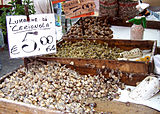Busycon
| Busycon | |
|---|---|

| |
| A fossil shell of Busycon contrarium | |
| Scientific classification | |
| Domain: | Eukaryota |
| Kingdom: | Animalia |
| Phylum: | Mollusca |
| Class: | Gastropoda |
| Subclass: | Caenogastropoda |
| Order: | Neogastropoda |
| Superfamily: | Buccinoidea |
| Family: | Busyconidae |
| Subfamily: | Busyconinae |
| Genus: | Busycon Röding, 1798 |
| Type species | |
| Busycon muricatum Röding, 1798
| |
| Species | |
|
See text | |
| Synonyms | |
|
Fulgur Montfort, 1810 | |
Busycon is a
Busycon comes from the
Shell description
Shells of species in this genus can grow to a length of 40 cm.
The shell is pyriform. The body whorl is large, nodulous or spinose. The spire is very short. The aperture is large and subtriangular. The siphonal canal is open, elongated, entire at the fore part. The inner lip is concave, with a single fold anteriorly. The outer lip is internally striated.[3]
The shells are generally a solid
The shell of individuals can sometimes vary quite widely in coloration and sculpture.
Behavior
Busycon whelks are
The
Eggs
Strings of Busycon whelk
Human use
When used for cooking in the United States, busycon whelks are sometimes called scungilli, an
Species
The genus Busycon contains the following species:[4]
- Busycon carica (Gmelin, 1791) - Knobbed whelk
- Busycon contrarium(Conrad, 1840) †
- Species brought into synonymy
- Busycon (Sinistrofulgur) aspinosum Hollister, 1958: synonym of Sinistrofulgur sinistrum (Hollister, 1958)
- Busycon (Sinistrofulgur) perversum (Linnaeus, 1758): synonym of Sinistrofulgur perversum (Linnaeus, 1758)
- Busycon (Sinistrofulgur) sinistrum Hollister, 1958: synonym of Sinistrofulgur sinistrum (Hollister, 1958)
- Busycon amoenum Conrad, 1875: synonym of Brachysycon amoenum (Conrad, 1875) †
- Busycon blakei Conrad, 1855 †: synonym of Pseudoperissolax blakei (Conrad, 1855) †
- Busycon candelabrum Lamarck, 1816 - Splendid whelk: synonym of Lindafulgur candelabrum(Lamarck, 1816)
- Busycon coarctatum (Sowerby I, 1825): synonym of Busycoarctum coarctatum (G.B. Sowerby I, 1825)
- Busycon laeostomum Kent, 1982 - Snow whelk: synonym of Sinistrofulgur laeostomum (Kent, 1982)
- Busycon lindajoyceae Petuch, 1991 †: synonym of Lindafulgur lindajoyceae (Petuch, 1991) †
- Busycon lyonsi Petuch, 1987: synonym of Lindafulgur lyonsi (Petuch, 1987)
- Busycon muricatum Röding, 1798: synonym of Busycon carica(Gmelin, 1791)
- Busycon perversum - )
- Busycon plagosum Conrad, 1862: synonym of Fulguropsis plagosa (Conrad, 1863)
- Busycon pulleyi - Prickly whelk: synonym of Sinistrofulgur pulleyi (Hollister, 1958)
- Busycon sinistrum Hollister, 1958: synonym of Sinistrofulgur sinistrum (Hollister, 1958)
The following species have been moved from Busycon to the genus Busycotypus
- sutureof the shell.
References
- ^ Bouchet, P. (2015). Busycon Röding, 1798. In: MolluscaBase (2015). Accessed through: World Register of Marine Species at http://www.marinespecies.org/aphia.php?p=taxdetails&id=160183 on 2015-12-03
- ^ "busycon". Merriam-Webster Unabridged. Archived from the original on 2011-07-10. Retrieved 2009-07-21.
- ^ Adams, H. & Adams, A. (1853-1858). The genera of Recent Mollusca; arranged according to their organization. London, van Voorst. Vol. 1: xl + 484 pp.; vol. 2: 661 pp.; vol. 3: 138 pls
- ^ list of Busycon species at malacolog.org

